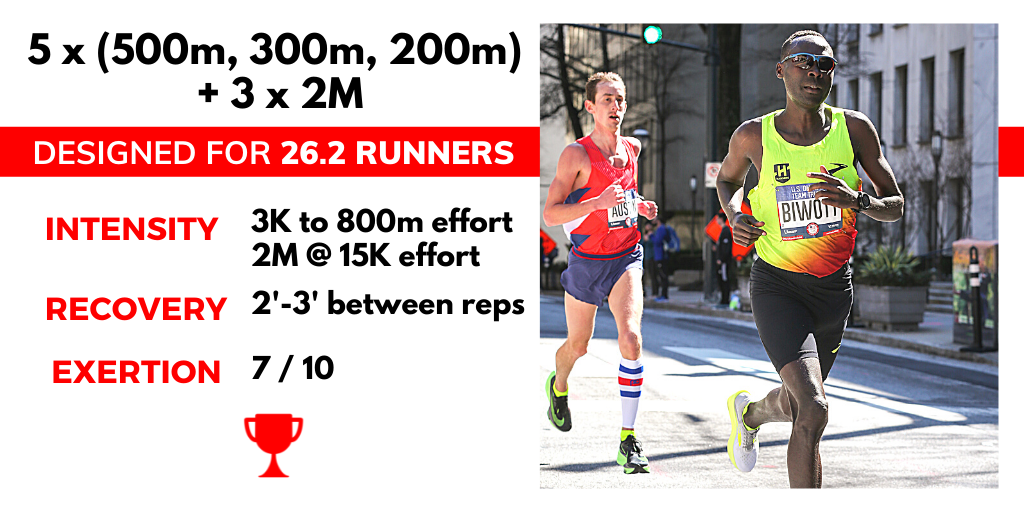5 x (500m, 300m, 200m) + 3 x 2M
5 x (500m, 300m, 200m) + 3 x 2M
Designed for 26.2 runners
Intensity
500m at 1500m effort, 300m at 800m effort, 200m at 400m effort
2M reps at 15K effort
Recovery
2 - 3 minutes walk/jog as desired between every rep
Exertion
7/10
Periodization
General Period
Context & Details
Most think good marathon training hinges upon tempo runs and high mileage.
Perhaps.
Although, these days I’ve become more skeptical of this approach.
A strong runner is a faster, more efficient, and overall better runner. The stronger the muscle, the less it has to contract to produce a given amount of force. This may be obvious, but it’s profound.
Stronger muscles upgrade running economy. When runners increase their movement economy, their perceived effort decreased, and it becomes easier — both physically and mentally — to run faster.
This is one reason why supershoes have advanced marathon times so dramatically. Due to the compression and spring effect of the midsole, the stance leg producing more force when it impacts the ground, spending less time to do so, which results in the legs “bouncing” off the ground higher, increasing stride length, projecting the body mass further, prolonging the flight phase of the stride cycle, and making muscles work less hard as a result.
Training for strength also has the same effect. And it’s why speed work and strength training is an important staple early in the successful marathoner’s training program.
When you run fast, you impact more force into the ground. By repeating the demand to run fast, the body is forced to recruit higher threshold motor units to strengthen the leg muscles to meet the task. Also, inter- and intra-muscle coordination is enhanced, making a runner’s stride more efficient and powerful.
Lots of slow running doesn’t do this. Slow running is a low-force situation. Yes, there will be significant developments to the cardiovascular system with high volumes of slow running, but leg strength will not advance that much.
Runners need to be strong, run fast, and train long in order to be race-ready for the marathon day.
If you want to get better results by learning more about successful marathon training methods, Join the Running Scholar Program for only $29 to get unlimited access to courses and 100+ training logs of elite marathoners.
In the book, Block Periodization, there is a chapter devoted to guidelines for sequencing exercises in a workout. The compatibility of types of work influences the magnitude of the training effect, reaction, and response.
Here’s a quick summary:
“Exercises for maximum speed, explosive strength, acquisition of new technical skills, and exercises to improve neural mechanisms of maximal strength require appropriate excitatory neural input and should be performed when the athlete is not fatigued. Exercises for anaerobic glycolytic endurance and maximal oxygen update can be fulfilled by moderately fatigued athletes who can still sustain the desired metabolic level. Exercises for strength endurance and aerobic endurance demand sustained efforts despite accumulated fatigue and can therefore take place towards the end of workouts.”
Different rep, set, and intensity schemes all correlate to different types of training load and stress.
Today’s workout is designed to address speed-endurance (with a higher emphasis on the speed component) with the 500m, 300m, 200m repeat breakdown sets and specific aerobic endurance stress for marathoners with the concluding 2 Mile repeats at 15K effort.
In the General Period, all workouts are performed by effort. The split on the watch doesn’t matter as the runner is developing qualities. Workout times in the general period should be really unimpressive as new motor skills and fitness are being developed. Progression throughout the period is what matters. This is why runners tend to revisit similar workout construction frequently in this period. It’s a way to verify that progress is happening.
Since there are multiple sets of 500m, 300m, 200m breakdowns a slight slow down in the later sets is expected as neural fatigue sets in. That’s OK. It’s a sign the workout is providing the desired stress.
With developmental workouts, we want to embarrass the body (and brain) by creating the necessary signaling needed to adapt and upgrade their speed-strength abilities.
The 10 - 15 minute workout bouts of the 2M repeats help to lay the foundation for the future focus of metabolic conditioning which will become the focal point of the marathoner’s training in later periods. I give my marathoners permission for “the times to suck” on these 2 Miles repeats — all that matters at this stage is the physiology is properly stressed. Just run reasonably hard, and get in the work in.
As the marathoner progresses to later training periods the foundation of speed-endurance laid early on will translate to significant upgrades in running economy. This, along with smart metabolic conditioning, will result in faster marathon race pace running without fear of hitting a wall on race day.
Any questions? Direct Message me on twitter.
Thx. | jm
Get Better Results with The Running Scholar Program.
Join the Running Scholar Program for $29 to learn more about successful Marathon Training and get unlimited access to courses and training programs on Marathon running.
3 Good Books on Marathon training
Advanced Marathoning by Peter Pfitzinger
From Last to First by Charlie Spedding
Endurance Training: Science and Practice edited by Iñigo Mujika


